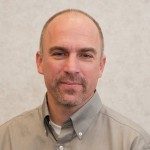The Macgyver moment: one of Kevin Oberholzer’s most memorable projects at Apple Rubber came, as he describes it, when he convinced “one of the guys from the machine shop to help me build a sweep for one of the LSR injection presses. We took sprockets, bicycle chain, a roller with rack and pinion to make a roller sweep that fit within the shroud of the press. This contraption allowed us to run many high volume O-ring projects automatically and cut the cycle time in half.”
Things have become a bit more sophisticated since Oberholzer’s inspired innovation, and today, Kevin is an outside project engineer who lives in the Philadelphia area and works with customers to find appropriate sealing configurations. The Maryland native and Old Dominion grad did not start his career at Apple Rubber, and he even left for a short time after moving from Western New York to Pennsylvania — but he’s back now, and we are glad to have him on the team.
What was your first role at Apple Rubber, and how did your career develop?
I joined the team at Apple Rubber to assist with new product design and help grow the manufacturing capabilities. Initially, our primary molding processes were compression and transfer molding. There was one custom engineered part with a membrane insert and gasket geometry. I had designed a transfer mold to make this silicone part. But that process was hard to control and final finishing was labor intensive. I researched the liquid injection molding process, the ability to fill the mold cavity at lower injection pressures, rapid material cure time, and improved machine process controls proved to be a solution.
Apple Rubber soon took delivery of our first injection machine and pumping unit. This was the beginning of our Liquid Silicone Rubber, LSR, department. In a few weeks, we were molding custom gaskets for an industrial application and making prototype parts for the membrane gasket. Within the next year, a vertical press was purchased for making prototype parts, and additional horizontal LSR injection machines were added to keep up with production projects. A second shift was soon added. We also designed molds and custom equipment for a number of projects to run lights-out.
I remember convincing one of the guys from the machine shop to help me build a sweep for one of the LSR injection presses. We took sprockets, a bicycle chain, and a roller with rack and pinion to make a roller sweep that fit within the shroud of the press. This contraption allowed us to run many high volume O-ring projects automatically and cut the cycle time in half. Now Apple is running multi axis robots controlled directly by the injection press.
The liquid injection molding department has matured quite a bit since those early years. Most presses have a sprue picker or robot for improved efficiency. The majority of our medical O-rings and seals are molded in a Class 10,000 clean room.
What do you see as the key to part design?
Understanding the manufacturing process is essential to every good part design. A specific design may look good in the computer model, even prototype well and meet performance requirements. However, if features of that design make it difficult to manufacture economically and consistently in large quantity, then the part design needs to change.
How did you end up in Philadelphia?
Soon after my wife and I had our first two children, we made the decision to move closer to family in the Philadelphia area. Yes, those Buffalo winters are tough and we did develop some great friendships while living there. I worked a few years for an Aerospace seal manufacturer near Philadelphia. I rejoined the team at Apple Rubber again as an outside project engineer.
Describe your favorite part of your work.
Variety is the best part of this job. I find it fulfilling to assist our customers and work with their engineers to help solve their sealing applications. Although each application may be different, I have discovered that taking lessons learned from other applications and even other industries, most solutions can be found.
What do you do when you aren’t working?
Our family enjoys camping together, caring for foster children in our home, and are involved in our local church. I enjoy cycling (road bike) and running – I recently ran the NYC marathon this past November.
